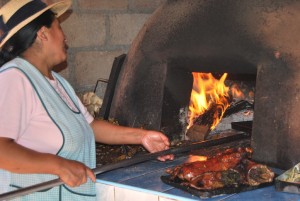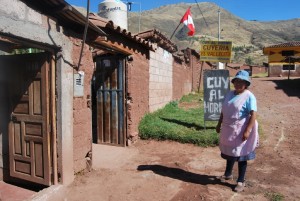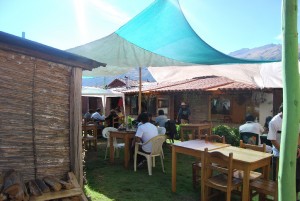Roast Cuy for Your Birthday

Emblematic of Peru, roast guinea pig (cuy al horno) is very important and popular in the city of Cuzco. While it attracts the attention of tourists, its greatest importance is in the lives of ordinary people. Hardly a birthday happens without cuy being prepared and served.
The dish is ancient. It may well date to the early days when Andean man hunted and gathered to feed himself. But for more than 5000 years the cuy has been domesticated and lives in the same houses as the people of the Andes. A very close relationship has developed.
Wild relatives of the cuy, such as the poronco (cavia tschudii), still live in the grasslands of the high plateaus and mountain valleys of the Andes chain. But thousands of years ago the cavia procellus, the domestic guinea pig, began living with people while the poronco continued in the wild.
In either case there are very social animals that live in very active groups and hide from the bright, Andean sun. It is generally thought that the domestic animal is smaller than its wild cousins which also have a dull brown color, unlike the rainbow of domestic cuy colors and hair styles.
In Cuzco today the cuy is considered a “typical” dish, which is to say that it stands for the essence of the city and its people. It has, as a result the high honor of being consumed only in festivities or very important days.

While this tradition may come from antiquity, and our grandfathers and grandmothers still carry the memory of this being an inheritance from the past, roast cuy not only tastes good, it carries a strong emotional charge for the people of Cuzco.
When a birthday dawns, the women of the house go the the hutch where the family’s guinea pigs live and begin the process of carefully preparing the cuy. Very early in the morning, when the rooster crows (as they say) they select from among the family’s cavies the ones to be sacrificed and begin the process.
The cuy is seasoned with the traditional Andean aromatic herb huacatay, which also grows in many people’s patios or gardens. Not only does the huacatay itself carry tradition, it also reaffirms the flavor of the cuy.
Once cleaned and seasoned, the guinea pigs are taken to the oven along with a dish of oven-baked noodles and the famous huayro potatoes. These tubers are famous for their fluffy texture when baked and for their delicious taste.

When combined with the noodles they bring a duality of carbohydrates–like so many other Andean things that come in twos–that is pleasing to the eye, heart, and taste while complementing the darker and earthier flavor of the baked cuy.
When families make baked cuy, instead of eating a mid-day lunch. as is the custom in the highlands, instead they eat around three or four in the afternoon to begin a celebration, whether of a birthday or some other festivity. This tradition has come down through the generations.
In the countryside the cuy is also important as a festive dish or one to honor distinguished guests. There they don’t use the oil or other ingredients we use in the city, but it is made with the plants that are found in their communities and house gardens, such as muña (minthosathcys mollis), a mint like wild plant, giving it a distinctive and very local flavor.
There the prepared guinea pigs are tied to a clean stick and are placed close to a large fire. Periodically they are turned to ensure they cook evenly. Being roasted in this fashion makes them taste even better.

While the modern families of today still carry this tradition, there are some among whom the knowledge of how to prepare the cuy has been lost. As a result restaurants that specialize in guinea pigs, such as in the town of Tipon outside Cuzco where many cuy restaurants (cuyerías) are congregated. Tipon is the principle place where people can taste the best cuys made by the women of the town.
The restaurants have all that is necessary in order to spend a good time eating and having fun. All the restaurants have large, country gardens and lawns where one can enjoy the sunshine and play games either before or after eating the famous cuy al horno (roast cuy).
Each restaurant also has a traditional oven made with of bricks and mud, and fed with wood.
When arriving in Tipon, one is met by lots of people inviting them to eat a cuy in their restaurant. While open daily, Tipon especially fills on weekends with all kinds of families.

Besides Tipon, one can find cuy in the traditional picanterías in Cuzco’s neighborhoods. Each has herds of cuys raised near the rounded ovens in which they will be cooked. In some of the more traditional places, guinea pigs roam freely under the tables where guests eats their cousins.
The women who greet and serve the guests in the traditional picanterías of Cuzco say it is not wise to ever try and count the guinea pigs that one has. That is considered bad luck and will keep the guinea pigs from multiplying like the sands of the sea.
In home after home in Cuzco one hears the squeaks and squeals of guinea pigs and, when a birthday comes, the smell of roasting cuy fills one with energy and joy for the celebration. The cuy will remain uncounted for many years.





How can u bozos eat something as cute as a guinea pig. There cute, adorable, cute, nice, did i mention cute? wELL ANYWAY FOR U “PERUVIAN” people what if u8 run out of guinea pigs. What would u do then.